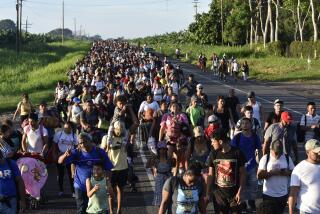Trouble Brewing
Finca Canaan is the promised land of coffee: a 95-acre farm of rich, volcanic soil in the middle of Juan Valdez country, at just the right altitude and latitude to produce a perfect cup.
Yet, in the last two years, manager Fabio Guerrero has ripped out two-thirds of the farm’s coffee bushes.
“Between the price and the berry borer [coffee’s equivalent of the boll weevil], coffee is not profitable anymore,” he explained.
That verdict echoes across the coffee axis--the rolling, misty foothills of the three mountain ranges in western Colombia where some of the world’s best coffee grows.
Growers are increasingly giving up, unable to tolerate the costly infestation and the weak prices caused by a glut on world markets.
Many growers are replacing coffee bushes with sugar cane, banana trees and fodder. The crisis that is transforming Finca Canaan threatens to wipe out an economic structure that for 70 years made Colombia’s 350,000 coffee-growing families the aristocracy of Latin American farmers.
Coffee provided a million jobs as well as one of the few points of stability in a country in constant upheaval. Already, some laborers have migrated from coffee fields to cocaine fields, where work remains plentiful.
The problems in Colombia’s coffee region began in 1989, when an international agreement between consuming and producing nations collapsed. The once-stable coffee market was thrown into turmoil and prices began to slide.
Today, many of Colombia’s coffee growers are deciding that it’s simply not worth the cost to grow the beans at current wholesale prices of about $1 a pound, 38% lower than the 1989 price.
Meanwhile, the berry borer has been claiming more territory each year. It has spread over 1.7 million acres--60% of Colombia’s coffee region--in the last eight years. Colombian scientists are racing to develop new methods to fight the bug, avoiding pesticides that have been ineffective and may do more long-term harm than good. But so far, the borer is winning.
Experts expect the pest to reach virtually the entire coffee axis by 2000. The bug, which burrows through the scarlet berry into its twin coffee beans to lay eggs, has destroyed up to a third of many growers’ crops.
Exact figures aren’t available, but experts estimate that 10% of Colombia’s coffee land has been lost. In one province alone, 476 farmers have abandoned coffee since the berry borer arrived, according to local agronomists.
Chopping down coffee bushes is not a short-term decision. Coffee bushes take years to reach peak production; when growers get out of coffee, they are leaving for a long time. And their decision is resonating throughout this nation.
Segundo Cardona raised and educated six children on the income from a 7.4-acre coffee finca, or farm, called El Porvenir (“The Future”). Today, however, the farm is more a tribute to the past.
“At the time I was raising my family, coffee was very profitable,” he recalled. With profits from coffee, he and Matamelba, his wife of 38 years, built a two-story house with a red and yellow bamboo veranda on all sides, the classic style in picturesque coffee country. They installed a water heater in their tiled indoor bathroom. And, as do 95% of coffee growers, they have electricity. These services--luxuries available only to the rich in most of rural Latin America--did not come from the government. The Colombian National Coffee Federation, a private organization run by growers, pays for roads and electrical plants as well as for grade schools and farming research from a tax on the 90% of coffee production that is exported.
The federation is nearly a parallel government in much of coffee country, filling a vacuum left by the indifference in the capital, Bogota. In other parts of Colombia, that role has been taken by guerrillas, paramilitary groups or drug traffickers, but without the prosperity and tranquillity that coffee growers enjoy.
If coffee afforded their parents a comfortable lifestyle, the Cardona offspring see little future in the crop. None of their four sons works on the farm, and only one of his daughters is married to a coffee grower.
“I don’t blame them,” Cardona said, sitting at the wooden kitchen table beside a second-story window that overlooks his fields. “These days, a coffee finca does not generate enough income to raise a family respectably.
“Now the plagues have arrived, and the prices do not make up for [the cost of fighting them],” he said. “I can get by because my family is raised, but a finca like this one cannot support a family.”
Colombian coffee growers had become accustomed to raising a crop that did not require pesticides, and selling it for a reliable price, with the federation buying at a guaranteed price when the international market was low.
“Coffee here is like cash,” said Gabriel Cadena, director of the National Coffee Research Center, the federation’s research arm in nearby Chinchina.
*
The federation created Juan Valdez and the ad campaigns that have persuaded generations of consumers to demand Colombian coffee, which supplies 15% of world production and ranks second only to Brazil.
When coffee rust, a plant blight, slipped across the border from Brazil in 1982, the federation was ready with a new coffee hybrid, called Colombia, that resisted the disease.
When world prices plummeted with the collapse of the international coffee agreement in 1989, the coffee federation bought crops and warehoused them, waiting for prices to improve. But as prices remain depressed, the federation’s ability to continue offering a guaranteed amount is threatened.
Now, the coffee federation is testing its members’ confidence in the organization. It is challenging the conventional wisdom that the berry borer can be fought only with toxic chemicals.
Four Colombian PhD candidates at Cornell University on federation fellowships are looking for another Colombia hybrid that will resist the berry borer as well as coffee rust. Meanwhile, scientists in Chinchina are implementing organic anti-pest programs.
When the bug first invaded Colombia, coffee growers responded the way growers had in other countries--with heavy doses of highly toxic and expensive pesticides. In El Salvador, where the berry borer arrived a decade ago, growers successfully spray their fields at certain times in the coffee-growing season.
“We have learned to live with the berry borer,” said Eduardo Enrique Barrientos, chairman of Procafe, El Salvador’s coffee research foundation. (About 5% of El Salvador’s coffee crop is being ruined by the pest now, he estimates.)
However, that solution does not work in Colombia, according to scientists. Colombian coffee bushes produce year-round, unlike those in other countries. The constant availability of coffee berries means that the pest always has a place to lay eggs and a source of food. Occasional spraying will not eliminate the bug and will cause inestimable damage to the environment, federation scientists predict. Spraying kills not just the berry borer but also beneficial insects, they point out.
“In the long run, you are just fostering more plagues,” Cadena said. Instead, growers must fight the berry borer with a variety of techniques, scientists argue.
Their most exotic solution is tiny wasps about the size of gnats and imported from Africa, the berry borer’s homeland. These wasps are natural enemies of the pest. Three varieties of wasps attack the bug at different stages of its development.
Colombia has become the first country to raise wasps for release in fields infested with the berry borer. Using federation techniques, a dozen private laboratories now raise the wasps under contract to the federation and provide them free to members. Since 1990, 200,000 wasps of one variety have been released, and wasps of the other two varieties will be ready for release this year.
So far, results have been less than spectacular.
“Unless it is a heavy infestation, the wasps do not have enough berry borers to eat, and they die,” said Borney Otalva, the assistant administrator at El Rocio, a 47-acre coffee farm where wasps were released last year as an experiment. “But the wasps cannot stop a heavy infestation in time to save the crop. From now on, I am using pesticides.”
Growers have been more impressed with a fungus that grows in coffee fields and attacks the borer, covering it like a mummy. Heli Zuleta now has about a third of his 125 acres of coffee protected by the fungus. “It works well when there is not a serious infestation,” he said.
Federation scientists recently won Colombia’s National Science Prize for Sustainable Development for their organic methods for fighting the berry borer. But obtaining recognition from coffee growers has been more difficult.
“The laboratory is a lot different from real life,” said Cardona, the farmer who added that neither he nor his neighbors are using organic methods to combat the pest.
The federation has been more successful at convincing growers that they must harvest coffee berries continually as they ripen to deprive the berry borer of an incubator for its eggs. This prevention method is known as rerre.
*
Previously, Colombian growers sometimes let coffee berries sit on the bush. Not any more.
Federation officials estimate that rerre accounts for about 70% of the battle against the berry borer. It also accounts for much of the increased cost of fighting the bug.
Cesar Agusto Bedoya, 29, estimates that the cost of running his family’s 574 acres of coffee has increased 30% since the berry borer arrived three years ago. Most of that increase is in labor.
“The problem can be managed, but the profits are not the same as before,” Bedoya said. “The berry borer problem demands more of us, and many growers prefer less complicated crops.”
Those increased demands are forcing coffee growers to make difficult decisions. Zuleta has put one-fourth of his property on the market in order to pay for more modern farming techniques that will allow him to combat the berry borer on the rest of his land.
“Our economic level has fallen 60%,” he said of his family. “There are no more trips, there are no more new cars. We sold our penthouse and now live in a more economical place.” At 56, said Zuleta, “I had expected to be in the mountains fishing and enjoying life. Instead, my land up there is for sale.”
(BEGIN TEXT OF INFOBOX / INFOGRAPHIC)
No More, Thanks
Weak prices and a major infestation have taken a heavy toll on Colombia’s primary coffee-growing region, where the foothills of three mountain chains meet in the west.
More to Read
Sign up for Essential California
The most important California stories and recommendations in your inbox every morning.
You may occasionally receive promotional content from the Los Angeles Times.






